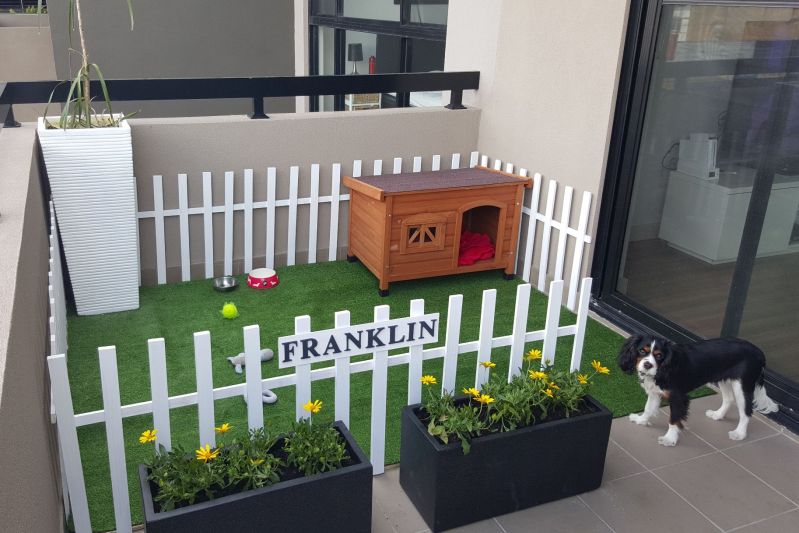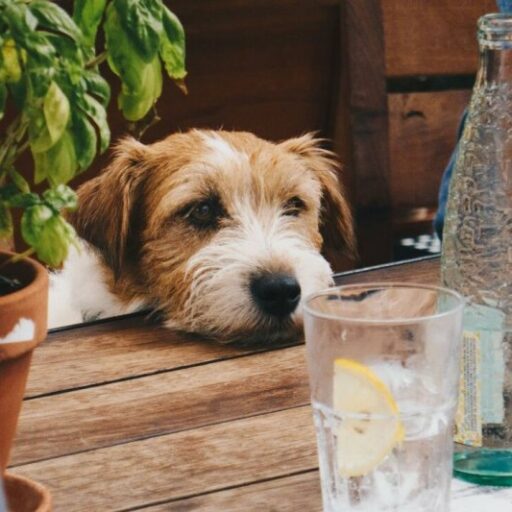Best Dog Friendly Ground Cover – One of the first steps to becoming pet-friendly is to create a space where dogs can be dogs—an outdoor space where they can run, play, and separate. You’ve found the right spot and installed it on the fence, but where exactly do the puppy’s paws meet? Choosing the right playing surface is an important decision and can mean the difference between an accessible space and a muddy mess. Keep reading to find out how to efficiently set up your playground without breaking the bank!
All of the floor coverings reviewed in this article fall into two categories: loose fill cover and solid cover. Pavement is made up of small and discrete pieces of loose material such as gravel, wood chips or sand and generally requires a bit more maintenance. As the dogs run around, the material will naturally shift and will eventually need to be re-rolled, leveled and straightened. Even coverage applies to hard flooring such as grass, kennel tiles or natural grass. Unlike a loose filling surface, a solid surface requires less maintenance to stay in place, but a little more to keep it clean and disinfected.
Best Dog Friendly Ground Cover

Our favorite material for dog toys is undoubtedly pea gravel! This finely ground and leveled gravel essentially serves as bedding for your dogs. This is a very economical solution ($0.50-$1.50 per square foot) and is available in many parts of the United States. It provides natural drainage that allows easy cleaning with selected products. Pea gravel also looks great in almost any landscape design, so you don’t have to sacrifice the aesthetics of your yard for your dog’s bathroom needs.
Pet-friendly Artificial Grass: Is It Worth It?
If you choose pea gravel for your chosen surface, remember that you will need to reapply the gravel from time to time. Some stones will be collected along with the dog’s feces, while others will settle into the soil. In general, the first application of gravel will sink into the soil more quickly than later, so plan to “top up” the surface after the first year and every 3-5 years thereafter. Remember that some dogs may try to swallow gravel, so it’s important to use a rounded stone that will pass easily through their digestive tract. The round stone is also gentle on the dog’s pads. Depending on the color chosen, the gravel may fade in direct sunlight. If you have a darker rock or are in a particularly hot climate, simply dab the dry rock with water to let it evaporate.
Before installing the pea gravel, you need to remove 3-4 inches of soil, grass, weeds and roots. If grass continues to grow through the gravel, apply a weed/grass killer such as Roundup and allow the product to dry (usually 24-48 hours) before allowing animals.
Wood chips are the most common type of flooring in dog parks today. They are relatively inexpensive and easy to install! There are a few things to consider before deciding on a course. First, let’s look at the two different types of wood chips you’re likely to encounter: mulch and engineered wood fibers.
Mulch consists of crushed or chopped pieces of wood, sometimes also bark, branches and leaves. It is usually very cheap ($0.15-$0.40 per square foot) and may even be free in many cities. Be aware, however, that locally sourced mulch often comes from locally felled trees and, depending on the quality of the shredder, may contain sharp pieces that can cause splinters or get stuck in a dog’s paw. Unlike locally sourced mulch, mulch purchased from a landscape company or container store has been shredded with a much finer wood chipper and is much less likely to contain sharp pieces of branches and twigs.
Plants You Can Walk On
Engineered Wood Fiber (EWF) is the most common type of flooring in children’s playgrounds. Unlike mulch, EWF is made from wood (inside the tree) and does not contain bark or twigs. It is ground to a fibrous consistency and sometimes treated or “knotted” to prevent splinters and sharp edges. Engineered wood fiber is much more expensive than mulch (about $4 per square foot).
Like gravel, wood chips naturally move as dogs run and play and need to be replaced periodically. Unlike gravel, wood chips wear out over time and usually don’t last more than two years before needing to be replenished.
Also remember that not all pieces of wood are safe for dogs to ingest. Some contain dyes, dangerous chemicals, and toxic ingredients, while others have odors that can entice your kitty to ingest them, causing an upset stomach. Pine bark, cedar bark, spruce bark, and cypress mulch are some of the best choices for dogs. Another good option is coconut mulch made from coconut husks (not to be confused with the dangerous cocoa mulch). On the other hand, definitely avoid eucalyptus mulch, chemically dyed/treated mulch, reclaimed wood mulch, and cocoa mulch.

Another disadvantage of wood chips is that they absorb very well. While this may seem like a great feature at first, it can mean that odors linger. Some homeowners report that their mulch areas smell awful after it rains. As with pea pods, preparing a wood chip playground requires removing 3 or 4 inches of soil, grass, and roots to prevent plant growth.
How To Build A Dog Potty Area Outside On Your Lawn
Grass can be a great option for larger yards where the cost of other materials is prohibitive. Depending on your space, this can happen naturally, saving you big upfront costs. Even if you have to install it yourself, weed is an incredibly cheap option. On average, grass costs between $0.35 and $0.80 per square foot. If you choose to seed grass, the cost will drop to about $0.10-$0.19 per square foot. The grass is soft on the dog’s paws and provides good natural drainage. It’s also a great choice if it’s stored well, stays fresh even in direct sunlight, and is safe for dogs (as long as you avoid herbicides and other chemicals).
Unfortunately, natural grass in high-traffic areas wears out quickly, leaving the soil bare. With the addition of rain, these lands can easily turn into mud pits. If you choose natural grass for your playground, keep in mind that you may need to close the yard at least partially from time to time during reseeding. Natural grass also requires maintenance with regular watering and trimming, which can increase costs over time.
Artificial grass is beautiful and durable. Depending on your budget, you may be able to afford a product that looks like real grass, but without the risk of wear and tear or the added expense of watering and trimming. Keep in mind that pet poop can be difficult to clean from longer grass fibers, so you’ll want to look for a product specifically for dog parks. In terms of price, artificial grass tops our list at about $15 per square foot, making it a tough choice for shelters on a budget.
While the highest quality products can last up to 7-10 years, grass must be installed by a professional if you expect such a long life. Installing a dog park lawn will require the removal of all existing weeds and grass and the application of a special drainage base layer to prevent urine from accumulating. Some common dog parks that use grass also have a concrete base with drainage pipes to ensure proper drainage of urine and cleaning products. However, this step is generally not necessary for smaller playgrounds.
Most Poisonous Landscape Plants For Dogs
When it comes to lawn cleaning, there are special products that can be sprayed and then hosed off. The frequency of cleaning will depend on the number of pets in your play yard, but large yards should be washed at least once or twice a week.
If the price isn’t enough to scare you off, lawn heat can be, even in cooler climates. A study at Brigham Young University found that the surface temperature was 37°F warmer than asphalt and 86.5°F warmer than natural grass when exposed to the same weather conditions. On an average summer day, an artificial grass surface can reach 165°F – hot enough to burn a dog’s paw in seconds. If you are interested in artificial grass as a base for your playground, make sure it is well shaded or be prepared to close the patio during the summer months.
Sand is a popular choice of bedding, especially for dog parks in coastal areas. It is relatively inexpensive (typically $1.50 to $3.00 per square foot) and can be attractive when there are no scraps. It also offers a great opportunity for swimming


